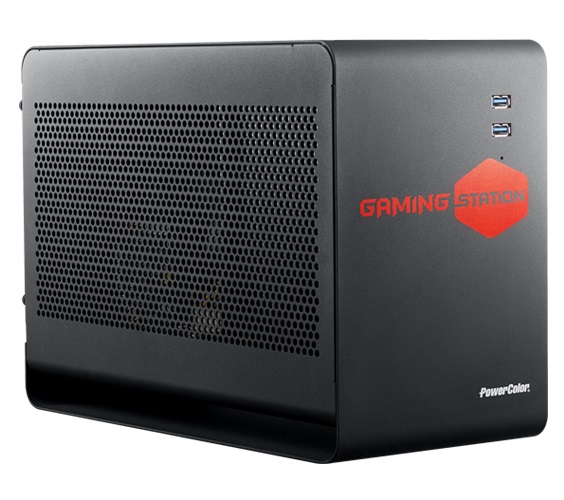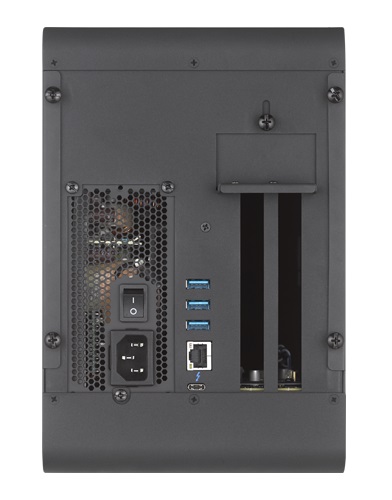PowerColor Announces Gaming Station: The Devil Box’s Spawn, TB3 eGFX Enclosure
by Joe Shields on December 14, 2017 11:00 AM EST- Posted in
- eGFX
- AMD
- PowerColor
- NVIDIA

PowerColor recently announced its second eGFX enclosure named, Gaming Station. The Gaming Station, like the Devil Box preceding it, is an accessory which enables gamers to connect desktop level video cards to laptops, AIOs, or SFF PCs using the Thunderbolt 3 interface. The Gaming Box is slightly smaller and moved away from the angular look of the Devil Box to a more traditional black, rectangular, almost UPS-like, appearance. It supports select NVIDIA and AMD GPUs through AMD's XConnect technology and comes with a 550W power supply able to easily power the compatible video cards. The Gaming Box joins an increasing number of TB3-based external enclosures with the ability to run desktop level video cards.
On the outside, the PowerColor Gaming Box is matte black with the Gaming Station and PowerColor name, as well as two USB 3.0 ports, on the front panel. All sides of the enclosure are closed off except for the left side which has small circle vents taking up most of that side to allow fresh air to enter and cool the video card inside. Surprisingly, we do not see any (RGB) LEDs on the enclosure. The dimensions are smaller coming in at 343.2 x 163 x 245mm (13.5” x 6.4” x 9.6”) versus 400 x 172 x 242mm on the Devil Box so portability has increased, if only by a small amount, via size.
The device uses a single Thunderbolt 3 port on the back panel able to offer 40 Gbps bandwidth. Internally, this translates to the installed graphics card able to access PCIe 3.0 x4 lanes. Both the TB and I/O cards are the same ones found in the Devil Box according to PowerColor. As time goes on and other options hit the market, we are seeing now dual TB3 connectivity for increased bandwidth and flexibility.PowerColor did not mention when or if this will be included in future iterations. In addition to the Thunderbolt 3 port, there are three more USB 3.0 ports as well as a Gigabit Ethernet port to enable high-speed wired internet on ultra-thin laptops or other devices that do not feature GbE.
Internally, the Gaming Box supports GPUs up to 310 x 157 x 46mm (12.2” x 6.2” x 1.8”), enough to support a double-wide video card, through a full-length PCIe slot running in PCIe 3.0 x4 mode. The Power Supply is also different now using an SFX format and rated at 550W 80 Plus Gold; an upgrade from the Devil Box at 500W. Unlike the Devil Box, the Gaming Box does away with 2.5” HDD/SSD support. If storage expansion is a goal through an eGFX enclosure, users will need to select the Devil Box instead.
| PowerColor Gaming Box Specifications | ||||
| Max Video Card Size | Double-Wide, 12.2" Long (310 × 157 × 46 mm) |
|||
| Max Video Card Power | 375 W | |||
| Connectivity | 1 × Thunderbolt 3 (40 Gbps) port to connect to host PCs and charge them 5 × USB 3.0 Type-A (2x Front Panel, 3x Back Panel) 1 × Gigabit Ethernet |
|||
| Chassis Size | 6.4 × 13.5 × 9.6 inches (163 × 343 × 245 mm) |
|||
| Internal PSU | 550 W | |||
| System Requirements | Thunderbolt 3 eGFX Certified PC Thunderbolt 3 w/Active Cable (included - 50cm) Windows 10 64bit Only |
|||
| Shipping Date | 1Q 2018 | |||
| Price | $379 / €419 | |||
For GPU compatibility, the Gaming Box lists AMD Radeon R9 285/290/290x/300 series, R9 Nano/Fury, and the RX400 and RX 500 series. On the NVIDIA side support ranges from the Kepler based 750/750Ti the 900 series, 1060/1070/1080/1080Ti, the Titan X/Xp, as well as select Quadro chipsets.
| PowerColor Gaming Box Video Card Compatibility List | |||
| AMD | NVIDIA | ||
| Radeon RX 500 Series | GeForce GTX 1080 / 1080 Ti | ||
| Radeon RX 400 Series | GeForce GTX 1070 | ||
| Radeon R9 Fury | GeForce GTX 1060 | ||
| Radeon R9 Nano | GeForce GTX Titan X / Titan Xp | ||
| Radeon R9 300 Series | GeForce GTX 980 Ti | ||
| Radeon R9 290X | GeForce GTX 980 | ||
| Radeon R9 290 | GeForce GTX 970 | ||
| Radeon R9 285 | GeForce GTX 960 | ||
| GeForce GTX 950 | |||
| GeForce GTX 750/750 Ti | |||
| NVIDIA Quadro P4000 / 5000 / 6000 / GP100 | |||
The Gaming Station will be available 12/15 with an MSRP of $329. This is priced less than the Devil Box's MSRP upon release ($399).
Related Reading:
Source: PowerColor












22 Comments
View All Comments
AdditionalPylons - Thursday, December 14, 2017 - link
I know this is not a review, but what chipsets power these? Are they likely to be Mac compatible like the Sonnet eGFX Breakaway Box or does each box require vendor-specific drivers?peevee - Thursday, December 14, 2017 - link
"a full-length PCIe slot running in PCIe 3.0 x4 mode"Isn't Thunderbolt only PCIe x1?
peevee - Thursday, December 14, 2017 - link
My bad, it is up to 2x capability on DP and LE controllers, and 4x on SP.ddrіver - Thursday, December 14, 2017 - link
Is my math right, is this a 830cu (13.6l) enclosure? I can fit a whole PC in there so what's the incentive to buy one of these?It's not portability because a laptop + this is about as portable as a PC + a monitor.
It's not to keep on the desk and plug the laptop because you can just plug an LCD into a similarly sized PC.
nagi603 - Thursday, December 14, 2017 - link
> I can fit a whole PC in there so what's the incentive to buy one of these?Simple: you don't want to buy a whole separate PC, you want something extra for your laptop, while still retaining the mobility it offers. Granted, you won't be packing it up, much like how you won't be packing up the extra monitor on your desk, or the office printer.
ddrіver - Thursday, December 14, 2017 - link
That was the whole question. Since clearly you can't carry it around portability is out the window. So you're buying a big "something extra" which accepts "select cards" and that you have to combine with something else to get a half decent compromise? And at that price you're not saving much if anything.Why not put the $400 towards a proper small PC with better overall experience? It won't be portable but you won't be stuck half way either. For almost the same money and portability you'd get a gaming machine without the need to mix it with anything else.
Creig - Thursday, December 14, 2017 - link
Some people might want to only have one PC to maintain instead of two, one PC for all their files instead of two, only have to purchase one license of certain programs rather than two, etc.vanilla_gorilla - Thursday, December 14, 2017 - link
The use case is really simple. I have a laptop, I do everything on my laptop, but I just need a little more oompf for gaming.Notmyusualid - Thursday, December 14, 2017 - link
+1.nerd1 - Thursday, December 14, 2017 - link
Yes, we already have 7.6L ITX case that houses a full 1080ti and 7700K CPU.Then we have full bandwidth (no performance loss), no headache with GPU connect/disconnect, and can keep one standalone system entirely for gaming.